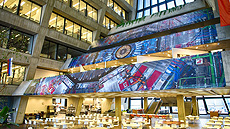Seeing the CMS experiment with new eyes
 |
| The wonders of particle physics serve as a springboard for a community-building arts initiative at Fermilab. Photo: Reidar Hahn |
For many, the aspects of research at the Large Hadron Collider that inspire wonder are the very same that cast it as intellectually remote: ambitious aims about understanding our universe, a giant circular machine in the European underground, mammoth detectors that tower over us like cathedrals.
The power of art lies in the way it bridges the gap between wonder and understanding, says particle physicist and artist Michael Hoch, founder and driving force behind the outreach initiative Art@CMS. Through the creation and consumption of art inspired by the CMS experiment at the LHC, the public and scientific community approach each other in novel ways, allowing one party to better relate to the other and demystifying the science in the process.
"Art can transport information, but it has an additional layer — a way of allowing human beings to get in touch with each other," says Hoch, who has worked as a scientist on CMS since 2007. "It can reach people who might not be interested in a typical science presentation. They might not feel smart enough, they might be afraid to be wrong. But with art, you cannot be wrong. It's a personal reflection."
As the hub for the United States' participation in the CMS experiment, Fermilab, located outside Chicago, is currently showing the Art@CMS exhibit in the Fermilab Art Gallery. Organized by gallery curator Georgia Schwender, the exhibit coincides with the restart of the LHC, which recently fired up again after a two-year break for upgrades. The exhibit is not only a celebration of the LHC restart, it also aims to create connections between artists and CMS physicists in the United States.
Each artist in the Fermilab exhibit collaborated with a CMS scientist in researching his or her work. Emphasizing the collaborative nature of the exhibit, the artwork title cards display both the name of the artist and the collaborating scientist. Drawing on their interactions, the artists created pieces that invite the viewer to see the experiment — the science, the instruments and the people behind it — with new eyes.
Read more
—Leah Hesla
|